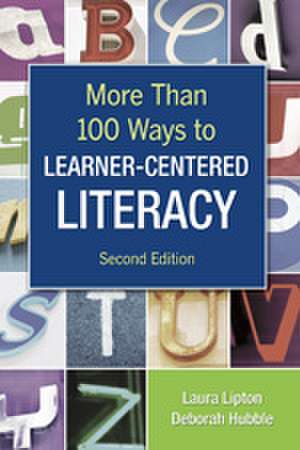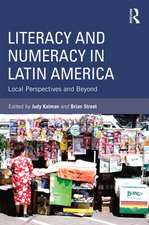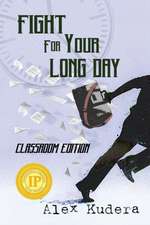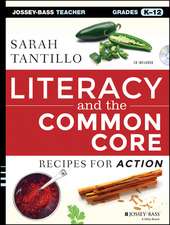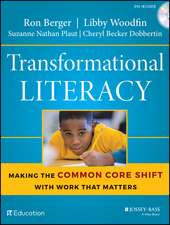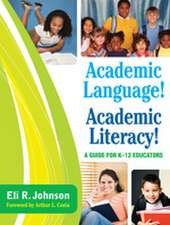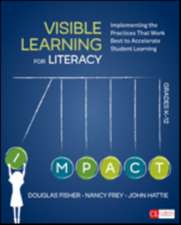More Than 100 Ways to Learner-Centered Literacy
Autor Laura Lipton, Deborah S. Hubbleen Limba Engleză Paperback – 22 oct 2008
Addresses the current educational environment
Presents additional strategies and examples
| Toate formatele și edițiile | Preț | Express |
|---|---|---|
| Paperback (1) | 241.94 lei 6-8 săpt. | |
| SAGE Publications – 22 oct 2008 | 241.94 lei 6-8 săpt. | |
| Hardback (1) | 463.80 lei 6-8 săpt. | |
| SAGE Publications – 4 noi 2008 | 463.80 lei 6-8 săpt. |
Preț: 241.94 lei
Nou
Puncte Express: 363
Preț estimativ în valută:
46.34€ • 47.74$ • 38.82£
46.34€ • 47.74$ • 38.82£
Carte tipărită la comandă
Livrare economică 22 februarie-08 martie
Preluare comenzi: 021 569.72.76
Specificații
ISBN-13: 9781412957830
ISBN-10: 1412957834
Pagini: 200
Dimensiuni: 152 x 229 x 20 mm
Greutate: 0.43 kg
Ediția:Second Edition
Editura: SAGE Publications
Colecția Corwin
Locul publicării:Thousand Oaks, United States
ISBN-10: 1412957834
Pagini: 200
Dimensiuni: 152 x 229 x 20 mm
Greutate: 0.43 kg
Ediția:Second Edition
Editura: SAGE Publications
Colecția Corwin
Locul publicării:Thousand Oaks, United States
Recenzii
“Both new and veteran teachers who truly embrace learner-centered literacy in their classroom will find the material useful, practical, and inexpensive.”
"Gives lots of easy ways to incorporate literacy development into the classroom. The book's format makes it extremely easy to understand.”
"Gives lots of easy ways to incorporate literacy development into the classroom. The book's format makes it extremely easy to understand.”
Cuprins
Publisher's Acknowledgments
About the Authors
Introduction
Section 1. Designing a Literate Environment
Learning Language by Using It
#1 Labels, Labels, Everywhere
#2 Where in the Room Is It?
#3 Wordstrings
#4 String ‘Em Up
#5 Hang-Ups
#6 Shoe Bag Classification
#7 Word Ribbons
#8 Class Mailbox
#9 Message Center
#10 Personal Word Banks
Building on Students’ Experiences
#11 Classroom Libraries
#12 Mainly Menus
#13 Taking Off With Advertising Flyers
#14 Weekly Words
#15 The Living Bulletin Board
Establishing Literacy Work Stations
#16 Work Station Rules
#17 The Key to Knowledge
#18 Housekeeping
#19 Introducing the Writing Work Station
Section 2. Orchestrating Student Interaction
Buddy Studies: Learning in Pairs
#20 Turn to Your Neighbor and . . .
#21 Level of Learning Reading Partners
#22 Learning Partners
#23 Paired Verbal Fluency
#24 Learning Partner Biographies
#25 Summary Pairs
#26 The King and Queen of Questions
Structuring Small Groups
#27 Story Map Trios
#28 Get the Point
#29 Peer Revision: Learning Together
#30 Peer Editing: Sharing Glows and Grows
Reading Conference: Flexible Student Grouping
#31 Establishing the Climate
#32 Student Preparation
#33 Temperature Checking
#34 Developing the Format
#35 Flexible Groupings
#36 One-on-One
Section 3. Developing Fluent Comprehension
Developing Skills by Increasing Fluency
#37 Choosing and Using Predictable Text
#38 Innovations on Text
#39 Toot! Toot!
#40 Radio Reading
#41 Say It Like the Character
#42 Reader’s Theater
#43 Partners Predict
#44 Opin
#45 Word Splash
#46 Say Something
Extending the Reading Experience
#47 Figures of Speech
#48 Create a Comic
#49 Finding Common Ground
Integrating Instruction
#50 Student-Selected Theme Topics
#51 Civic Projects
#52 Imagine If You Were ...
Section 4. Nurturing Lifelong Learners
Routines for Reading to, With, and by Children
#53 Read-Alouds
#54 Familiarity Breeds Confidence
#55 We Are Readers: A Class Record
#56 Sustained Silent Reading
#57 Guided Reading
Writing Centers: Reading/Writing Connection
#58 Readers/Writers Workshop
#59 Purposeful Tasks
#60 Published and Unpublished Work
#61 Paths to Publication
Building a Community of Learners
#62 Literature Clubs
#63 Join the Chorus
#64 Mine, Yours, and Ours
#65 Writing Autobiographies
Section 5. Assessing Student Growth
Kid-Watching in the Classroom
#66 Anecdotal Records
#67 A Nifty Notebook
#68 Sticky Helpers
#69 Individual Student Checklists
#70 Class Checklists
#71 Historical Checklists
#72 Interviews
#73 Open-Ended Questions
Student Portfolios
#74 Crate ‘Em Up!
#75 Bulky Bundles
#76 Portfolio Contents
#78 Portfolio-Prompted Planning
#79 Entry Slips
#80 Autobiographies of Work
#81 Biographies of Work
Exhibitions and Performance Tasks
#81 Building in Authenticity
#82 Anchors and Archetypes
#83 Developing a Rubric
#84 Exciting Exhibitions
Section 6. Leading Learning-Focused Conversations: Strategies for Professional Development
Crafting the Container: Starting, Structuring, and Sustaining Thinking
#85 Simple Stem Completions
#86 T-chart Opposites
#87 3-2-1
#88 Mindful Memorandum
#89 Brainstorm and Pass
#90 Problem-Solving Partnerships
#91 Going Graphic
Learning-Focused Consultation
#92 An Idea Menu
#93 Make Your Thinking Transparent
#94 Patterned Response: What, Why, How
#95 The Big Idea
#96 Categorically Speaking
#97 Sharing Causal Theories
Inviting Thinking: A Sampler of Questions for Literacy Coaching
#98 Questions for Planning
#99 Questions for Reflecting
#100 Questions to Stimulate Discussion
#101 Metaphor and Invention
Resources
Index
About the Authors
Introduction
Section 1. Designing a Literate Environment
Learning Language by Using It
#1 Labels, Labels, Everywhere
#2 Where in the Room Is It?
#3 Wordstrings
#4 String ‘Em Up
#5 Hang-Ups
#6 Shoe Bag Classification
#7 Word Ribbons
#8 Class Mailbox
#9 Message Center
#10 Personal Word Banks
Building on Students’ Experiences
#11 Classroom Libraries
#12 Mainly Menus
#13 Taking Off With Advertising Flyers
#14 Weekly Words
#15 The Living Bulletin Board
Establishing Literacy Work Stations
#16 Work Station Rules
#17 The Key to Knowledge
#18 Housekeeping
#19 Introducing the Writing Work Station
Section 2. Orchestrating Student Interaction
Buddy Studies: Learning in Pairs
#20 Turn to Your Neighbor and . . .
#21 Level of Learning Reading Partners
#22 Learning Partners
#23 Paired Verbal Fluency
#24 Learning Partner Biographies
#25 Summary Pairs
#26 The King and Queen of Questions
Structuring Small Groups
#27 Story Map Trios
#28 Get the Point
#29 Peer Revision: Learning Together
#30 Peer Editing: Sharing Glows and Grows
Reading Conference: Flexible Student Grouping
#31 Establishing the Climate
#32 Student Preparation
#33 Temperature Checking
#34 Developing the Format
#35 Flexible Groupings
#36 One-on-One
Section 3. Developing Fluent Comprehension
Developing Skills by Increasing Fluency
#37 Choosing and Using Predictable Text
#38 Innovations on Text
#39 Toot! Toot!
#40 Radio Reading
#41 Say It Like the Character
#42 Reader’s Theater
#43 Partners Predict
#44 Opin
#45 Word Splash
#46 Say Something
Extending the Reading Experience
#47 Figures of Speech
#48 Create a Comic
#49 Finding Common Ground
Integrating Instruction
#50 Student-Selected Theme Topics
#51 Civic Projects
#52 Imagine If You Were ...
Section 4. Nurturing Lifelong Learners
Routines for Reading to, With, and by Children
#53 Read-Alouds
#54 Familiarity Breeds Confidence
#55 We Are Readers: A Class Record
#56 Sustained Silent Reading
#57 Guided Reading
Writing Centers: Reading/Writing Connection
#58 Readers/Writers Workshop
#59 Purposeful Tasks
#60 Published and Unpublished Work
#61 Paths to Publication
Building a Community of Learners
#62 Literature Clubs
#63 Join the Chorus
#64 Mine, Yours, and Ours
#65 Writing Autobiographies
Section 5. Assessing Student Growth
Kid-Watching in the Classroom
#66 Anecdotal Records
#67 A Nifty Notebook
#68 Sticky Helpers
#69 Individual Student Checklists
#70 Class Checklists
#71 Historical Checklists
#72 Interviews
#73 Open-Ended Questions
Student Portfolios
#74 Crate ‘Em Up!
#75 Bulky Bundles
#76 Portfolio Contents
#78 Portfolio-Prompted Planning
#79 Entry Slips
#80 Autobiographies of Work
#81 Biographies of Work
Exhibitions and Performance Tasks
#81 Building in Authenticity
#82 Anchors and Archetypes
#83 Developing a Rubric
#84 Exciting Exhibitions
Section 6. Leading Learning-Focused Conversations: Strategies for Professional Development
Crafting the Container: Starting, Structuring, and Sustaining Thinking
#85 Simple Stem Completions
#86 T-chart Opposites
#87 3-2-1
#88 Mindful Memorandum
#89 Brainstorm and Pass
#90 Problem-Solving Partnerships
#91 Going Graphic
Learning-Focused Consultation
#92 An Idea Menu
#93 Make Your Thinking Transparent
#94 Patterned Response: What, Why, How
#95 The Big Idea
#96 Categorically Speaking
#97 Sharing Causal Theories
Inviting Thinking: A Sampler of Questions for Literacy Coaching
#98 Questions for Planning
#99 Questions for Reflecting
#100 Questions to Stimulate Discussion
#101 Metaphor and Invention
Resources
Index
Notă biografică
Laura Lipton is codirector of MiraVia, LLC, a publishing and development firm in Sherman, CT. Lipton is an international consultant whose writing, research, and seminars focus on effective and innovative instructional practices and building professional and organizational capacities for enhanced learning. She engages with schools and school districts, designing and conducting workshops on organizational development, learning-focused instruction, literacy development, and strategies to support beginning teachers. Lipton applies her extensive experience with adult learners to workshops and seminars conducted throughout the United States, Canada, Europe, Australia, and New Zealand on such topics as learning-focused relationships, data-driven dialogue, teacher leadership, action research, and learning-focused mentoring. She is the author and coauthor of numerous publications related to organizational and professional development, learning-focused schools, and literacy development.
Descriere
Packed with stimulating activities and innovative strategies, this how-to book addresses all levels of learner-centered instruction and literacy.
